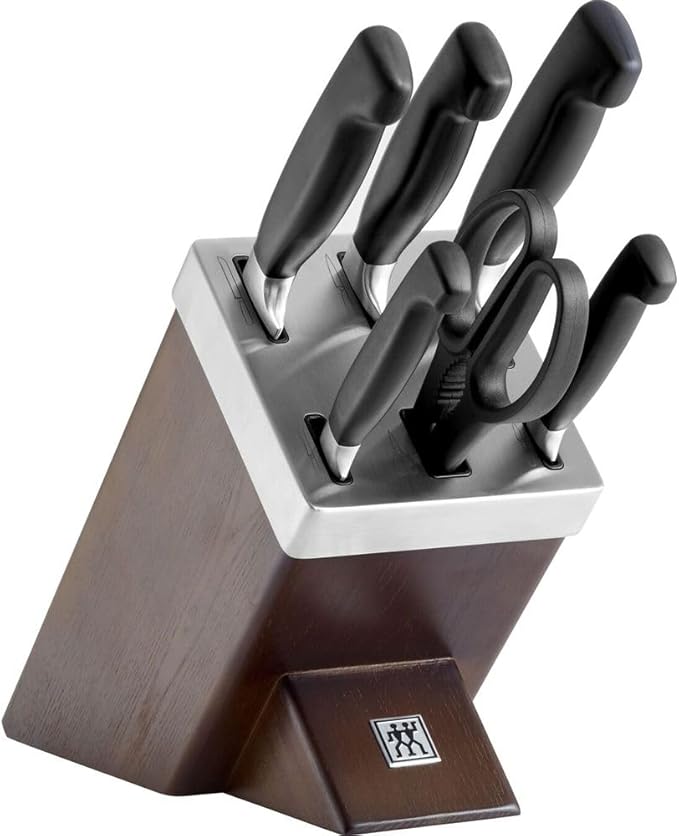Cutting is the first step in making a great meal, whether it’s slicing vegetables, dicing onions, or carving meat. Kitchen knives are the most important tool in the kitchen, and they are what make every cut perfect.
The right knife makes cooking faster, safer, and more fun for both home cooks and professional chefs. But it can be hard to choose the right one because there are so many shapes, sizes, and materials. This guide will teach you everything you need to know about kitchen knives, including the different types, how to use them, how to care for them, and why it’s worth it to buy a good one.
Why It’s Important to Have Good Kitchen Knives
It’s not just about following recipes when you cook; it’s about how you do it. A dull or poorly made knife doesn’t just slow you down; it can also make cooking more difficult and even dangerous. Sharp, well-made kitchen knives make cooking more precise, less work and more fun.
In this way, a musician needs a good instrument, a painter needs good brushes, and a cook needs knives that work well.
What Different Kinds of Kitchen Knives Are and What They Do
Not every knife is good for every job. Here are the most common kinds of kitchen knives and what they’re best for:
1. Knife for Chefs
The knife that can do the most things and is the most important. The wide, sharp blade is great for cutting meat, chopping vegetables, and even mincing garlic.
2. Knife for paring
It’s small and light, so it’s great for delicate tasks like peeling fruit, deveining shrimp, or trimming vegetables.
3. Knife with a serrated blade (bread knife)
This knife has a saw-like blade that cuts through bread, tomatoes, and other foods with tough outsides and soft insides without leaving any mess.
4. Knife for Santoku
This knife is great for slicing, dicing, and chopping in the Japanese style. Its shorter, thinner blade makes it easier to use for quick cuts.
5. Knife for carving
Long and thin, made for cutting up cooked meats like turkey, ham, or roast beef.
6. Knife for Boning
It has a thin, flexible blade that makes it easy to take bones out of meat, poultry, and fish.
7. Chopper
This knife is heavy and strong enough to cut through bones and break down big pieces of meat.
8. Knife for utility
It falls between a paring knife and a chef’s knife. Useful for things like cutting sandwiches or chopping up medium-sized vegetables.
What Kitchen Knives Are Made Of
The type of material used for the blade affects how sharp it is, how long it lasts, and how easy it is to care for. These are the most common:
- Stainless steel is cheap, easy to care for and doesn’t rust.
- High-carbon steel is very sharp and long-lasting, but it is more likely to rust if you don’t take care of it.
- Ceramic is very sharp and light, but it’s also fragile and hard to sharpen at home.
- Damascus Steel is known for being strong, having unique patterns, and being of high quality.
How to Pick the Best Kitchen Knives
Things to think about when buying kitchen knives:
- Comfort and grip: A knife should feel balanced and good in your hand.
- Sharpness: A good knife should cut with ease.
- Durability: Choose materials that work well with the way you cook.
- Maintenance: Some knives need to be sharpened and cleaned carefully on a regular basis.
- Purpose: Buy knives that are good for the kind of cooking you do most.
Important Knives That Every Kitchen Needs
Professional chefs may use a dozen different knives, but home cooks can start with these three:
- Chef’s Knife: For most chopping, slicing, and dicing.
- Paring Knife: For fine and precise work.
- Serrated Knife: For bread, cakes, and soft fruits.
You can do 90% of the work in the kitchen with these three.
How to Take Care of Your Kitchen Knives
If you take care of it, a good knife can last for a long time. Here are some important tips:
- Hand wash only; don’t use a dishwasher because the high heat and detergents can hurt the blades and handles.
- Dry right away to keep rust and water damage from happening.
- Use a cutting board, preferably one made of wood or plastic. Glass or marble will dull blades quickly.
- Keep them safe by using a knife block, a magnetic strip on the wall, or blade guards.
- Sharpen Often: A honing steel keeps your knife sharp between full sharpening sessions.
Things People Do Wrong with Kitchen Knives
Even the best kitchen knives won’t work well if you don’t use them right. Don’t make these mistakes:
- Cutting on hard surfaces, like stone countertops.
- Use one knife for each job (don’t use a chef’s knife for bread or bones).
- Putting knives in a drawer without any protection.
- Not sharpening until the blade is completely dull.
Famous Kitchen Knife Brands
When you want to buy something of good quality, these brands stand out:
- Wüsthof knives are made in Germany and are strong and accurate.
- Shun: Japanese craftsmanship with very sharp blades.
- Victorinox is cheap but works very well.
- Global: Sharp, sleek, and light.
- Zwilling J.A. Henckels is a well-known brand that makes professional-grade knives.
Last Thoughts
In the kitchen, the right knives are more than just tools; they are an extension of your hands. A sharp, dependable knife makes cooking easier, faster, and more fun, whether you’re making a simple salad or a fancy meal.
If you buy good knives and take care of them, you’ll be able to slice and chop with ease for many years. Don’t forget: the tools you use to cook are just as important as the recipes.

